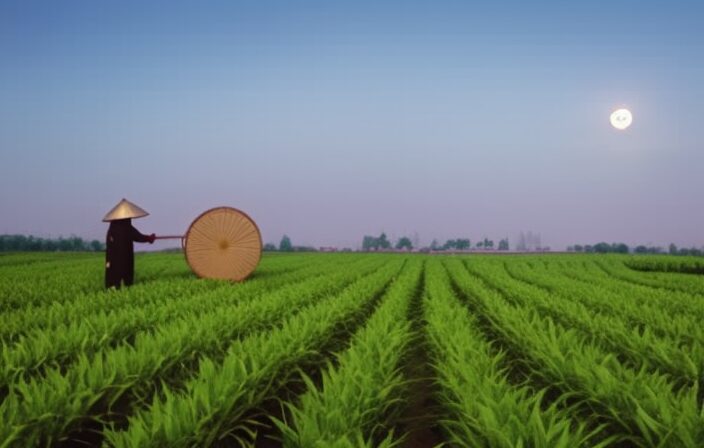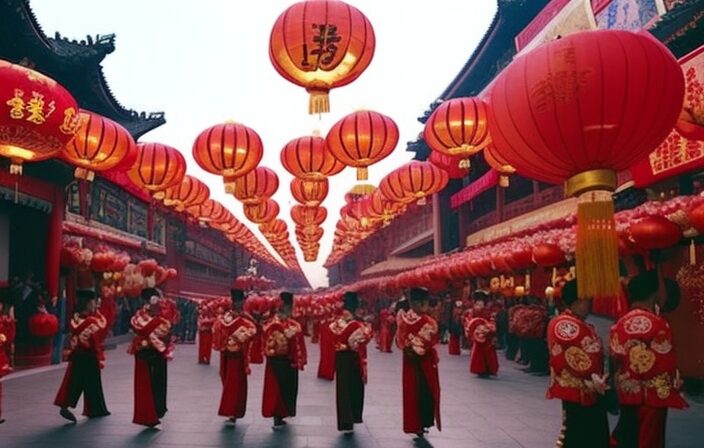In the rich tapestry of Chinese agricultural practices, the influence of the lunar calendar looms large. Through a careful juxtaposition of time-honored traditions and scientific observations, this article explores the profound impact of the lunar calendar on Chinese agriculture.
Drawing on historical significance, planting strategies, harvesting practices, weather patterns, and traditional festivals, we delve into the intricate relationship between the lunar cycles and the successful cultivation of crops.
Furthermore, we examine how the lunar calendar continues to find relevance in modern Chinese agriculture.
Key Takeaways
- The lunar calendar is deeply integrated into Chinese agriculture, guiding planting schedules, harvesting activities, and fishing strategies.
- Lunar phases and festivals provide guidance for optimal planting and harvesting times, taking into account weather predictions and traditional medicine practices.
- Traditional festivals based on the lunar calendar celebrate important agricultural milestones, bringing communities together and strengthening cultural heritage.
- Modern agricultural practices in China still utilize the lunar calendar, with farmers using lunar calendar-based apps to optimize farming activities, reduce waste, and preserve natural resources.
Historical Significance of the Lunar Calendar in Chinese Agriculture
The historical significance of the lunar calendar in Chinese agriculture is evident in the meticulous planning and timing of crop cultivation practices. The lunar calendar, based on the cycles of the moon, has long been used in traditional farming techniques in China. This calendar not only serves as a guide for farmers in determining the optimal time for planting and harvesting crops but also holds cultural significance in agricultural practices.
The lunar calendar has a profound influence on traditional farming techniques in China. Farmers rely on the lunar calendar to determine the best time to sow seeds, transplant seedlings, and harvest their crops. They believe that aligning their farming activities with the lunar cycles ensures better crop yields and quality. For example, the lunar calendar dictates that certain crops should be planted during specific lunar phases, such as root vegetables during the waxing moon and leafy greens during the waning moon. This careful timing is believed to enhance the plants’ growth and vitality.
Moreover, the lunar calendar’s influence on Chinese agriculture goes beyond its practical applications. It has deep cultural significance and is intricately woven into the fabric of Chinese society. The lunar calendar is an integral part of traditional festivals and celebrations associated with agriculture, such as the Spring Festival and the Mid-Autumn Festival. These festivities not only mark the changing seasons but also pay homage to the agricultural heritage of the Chinese people.
Lunar Cycles and Planting Strategies in Chinese Farming
Planting strategies in traditional Chinese farming are closely tied to the cycles of the moon. The lunar calendar plays a significant role in determining the optimal time for planting various crops. Traditional Chinese farmers believe that the different phases of the moon have a direct influence on the growth and development of plants.
According to traditional Chinese medicine, the lunar phases affect the flow of energy in plants, influencing their vitality and nutritional value. For example, during the waxing moon phase, when the moon is growing brighter, the energy is believed to rise, making it an ideal time for planting crops that produce fruits above the ground, such as tomatoes and peppers. On the other hand, during the waning moon phase, when the moon is getting smaller, the energy is believed to descend, making it a suitable time for planting root crops like potatoes and carrots.
In addition to planting strategies, the lunar calendar also influences fishing strategies in traditional Chinese farming. Fishermen often consult the lunar calendar to determine the best times for fishing. They believe that the moon’s gravitational pull affects the behavior and migration patterns of fish. By aligning their fishing activities with the lunar calendar, fishermen aim to increase their chances of a successful catch.
Overall, traditional Chinese farming practices demonstrate a deep understanding of the natural world and its interconnectedness. The lunar calendar serves as a guide for both planting and fishing strategies, allowing farmers and fishermen to maximize their productivity and enhance their livelihoods.
Harvesting and the Lunar Calendar: Traditional Practices in Chinese Agriculture
Traditional practices in Chinese agriculture revolve around the lunar calendar, which plays a crucial role in determining the timing of various farming activities.
Harvesting, in particular, is closely tied to the lunar phases and festivals, as they provide farmers with guidance on when to reap their crops.
These practices also take into account weather predictions based on lunar observations, ensuring that the harvest is conducted under optimal conditions.
Planting Schedules and Phases
Aligned with the lunar calendar, the Chinese agricultural system meticulously follows specific schedules and phases for cultivation. Lunar phases play a significant role in determining the optimal time for planting crops. Farmers in China practice lunar gardening, which involves aligning the planting and harvesting of crops with the lunar phases.
The lunar calendar serves as a guide, indicating when to sow seeds, transplant seedlings, and apply fertilizers. This traditional practice is deeply rooted in Chinese culture and has been followed for centuries.
The lunar calendar’s influence extends beyond agriculture and is also intertwined with traditional medicine. Traditional Chinese medicine practitioners believe that certain plants have different healing properties depending on when they are harvested, based on the lunar calendar. Therefore, the lunar calendar serves as a valuable tool for farmers and traditional healers alike, ensuring the cultivation and utilization of crops at their most potent and beneficial stages.
Lunar Festivals and Rituals
The celebration of lunar festivals and the performance of associated rituals hold great cultural significance in China. These traditions are deeply rooted in the lunar calendar’s cultural significance, which has been an integral part of Chinese society for centuries.
The lunar festivals, such as the Spring Festival (Chinese New Year) and the Mid-Autumn Festival, are based on the lunar calendar and mark important events in the agricultural cycle. These festivals serve as an opportunity for families to come together, pay respects to ancestors, and pray for good fortune and a bountiful harvest.
The rituals performed during these festivals, such as lighting lanterns or offering sacrifices, are believed to bring good luck and prosperity. The lunar festival traditions not only reflect the agricultural heritage of China but also strengthen familial and communal bonds.
Weather Predictions and Farming
Weather predictions play a crucial role in informing farming practices and ensuring a successful harvest. Farmers around the world rely on accurate weather forecasting to make informed decisions about planting, irrigation, and crop protection.
In Chinese agriculture, the lunar calendar and its association with different weather patterns have been used for centuries to guide farming activities. The lunar phases, in particular, are believed to influence weather conditions, with certain phases associated with specific weather patterns. For example, the full moon is associated with calm and clear weather, while the new moon is linked to stormy and unpredictable conditions.
These lunar-based weather predictions are not only used in agriculture but also in other traditional activities, such as fishing, where certain lunar phases are believed to affect fish behavior and catch rates.
Overall, the integration of lunar-based weather forecasting into farming practices showcases the rich cultural heritage and practical knowledge passed down through generations in Chinese agriculture.
Weather Patterns and the Lunar Calendar: Understanding Natural Rhythms for Crop Growth
One key aspect of the lunar calendar’s influence on Chinese agriculture is its ability to provide insights into natural rhythms that affect crop growth. The understanding of lunar phases and their impact on crop yield has been passed down through generations in Chinese farming communities. Farmers have observed that certain lunar phases coincide with specific weather patterns, which in turn influence crop growth. This knowledge has enabled them to plan their planting and harvesting schedules accordingly, maximizing their chances of a successful harvest.
The lunar calendar’s impact on crop yield is significant, as it helps farmers anticipate and adapt to changing weather conditions. By aligning their farming activities with lunar phases, farmers can take advantage of favorable weather patterns, such as increased rainfall during certain lunar phases, to optimize crop growth. On the other hand, they can also prepare for adverse weather conditions, such as heavy rains or droughts, that tend to occur during specific lunar phases.
The ability to understand and utilize the lunar calendar’s influence on agriculture is crucial for Chinese farmers, as it allows them to work in harmony with nature and increase their chances of a bountiful harvest. It also fosters a deep connection between farmers and the natural world, as they rely on the rhythms of the moon to guide their farming practices.
- The lunar calendar provides a sense of stability and predictability in an unpredictable environment.
- Farmers feel a sense of awe and wonder at the intricate relationship between lunar phases and crop growth.
- The lunar calendar fosters a deep connection between farmers and the natural world.
- The ability to harness the lunar calendar’s influence on agriculture gives farmers a sense of control over their livelihoods.
- The lunar calendar’s impact on crop yield reinforces the importance of traditional knowledge and practices in farming communities.
Traditional Festivals and the Lunar Calendar: Celebrating Agricultural Milestones
Traditional festivals in Chinese culture play a vital role in celebrating agricultural milestones according to the lunar calendar. These festivals have deep-rooted cultural significance and are celebrated with great enthusiasm and fervor. They not only serve as a way to pay tribute to the agricultural cycle but also bring communities together, fostering a sense of unity and shared heritage.
One such festival is the Spring Festival, also known as Chinese New Year, which marks the beginning of the lunar calendar and the arrival of spring. It is a time when farmers celebrate the end of winter and the start of a new planting season. Festivities include family gatherings, exchanging gifts, and offering sacrifices to deities for a prosperous harvest.
Another important agricultural festival is the Mid-Autumn Festival, which falls on the 15th day of the eighth lunar month. It is a time when farmers celebrate the harvest and express gratitude for the bountiful crops. Families come together to enjoy mooncakes and appreciate the full moon, symbolizing unity and abundance.
These festivals reflect the deep connection between Chinese culture and agriculture. They not only serve as a reminder of the importance of agricultural milestones but also celebrate the traditions and values that have been passed down through generations. By honoring these festivals, the Chinese people continue to preserve their cultural heritage and strengthen their sense of identity.
Modern Applications: Incorporating the Lunar Calendar in Contemporary Chinese Agriculture
The integration of the lunar cycle into modern agricultural practices in China showcases the relevance and adaptability of traditional cultural elements in contemporary contexts. By incorporating technology, farmers are able to utilize the lunar calendar to enhance sustainable farming practices and optimize crop yields.
-
Increased Efficiency: Farmers can use lunar calendar-based apps to track the lunar phases and align their planting and harvesting schedules accordingly. This helps maximize productivity and minimize waste.
-
Natural Pest Control: The lunar calendar also guides farmers in implementing natural pest control methods. For example, certain lunar phases are believed to be less favorable for pests, allowing farmers to reduce the use of chemical pesticides.
-
Water Management: The lunar calendar is also used to manage water resources. By considering the lunar phases, farmers can determine the optimal time for irrigation and ensure efficient water usage.
-
Soil Fertility: Lunar calendar-based practices such as applying organic fertilizers during specific lunar phases are believed to enhance soil fertility and nutrient absorption by crops.
-
Environmental Sustainability: By following lunar calendar-based practices, farmers can reduce their reliance on synthetic agrochemicals and promote environmentally sustainable farming methods.
Overall, the incorporation of the lunar calendar into modern agriculture in China demonstrates the potential for traditional cultural elements to contribute to sustainable farming practices and crop yield optimization.
How Does the Lunar Calendar Influence Chinese Medicine?
The lunar calendar’s impact on chinese medicine is profound. It serves as a guiding force, influencing diagnosis, treatment, and overall wellness practices. Traditional Chinese medicine practitioners believe that the energy of the moon cycles affects the body’s vital energy, or Qi. By aligning treatments and therapies with the lunar calendar, they aim to enhance the effectiveness and balance of healing methods. This ancient connection between the lunar calendar and Chinese medicine continues to be respected and utilized today.
Conclusion
In conclusion, the lunar calendar has played a significant role in Chinese agriculture for centuries. Farmers have relied on lunar cycles to determine optimal planting and harvesting times, as well as to understand weather patterns for crop growth.
Traditional festivals also mark important agricultural milestones.
Today, the lunar calendar continues to be incorporated in contemporary Chinese agriculture, showcasing the enduring influence of this ancient practice. Interestingly, studies have shown that crop yields can increase by up to 15% when planting is aligned with the lunar calendar, highlighting its potential impact on agricultural productivity.



